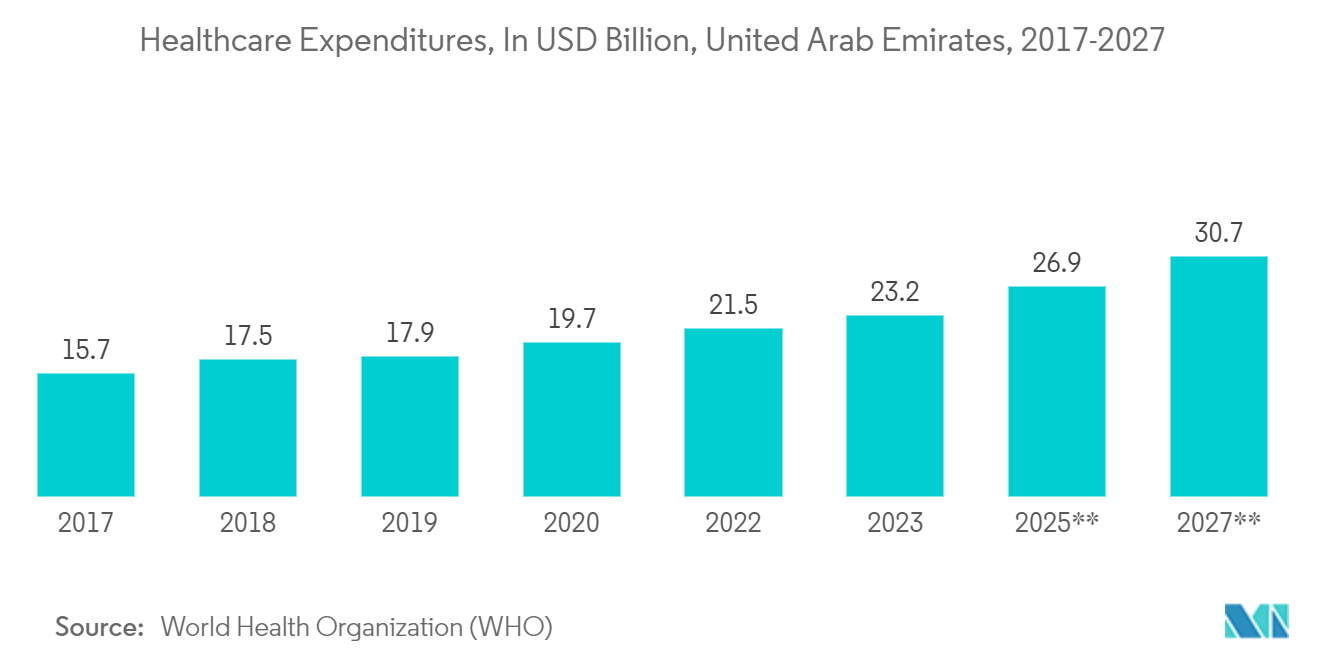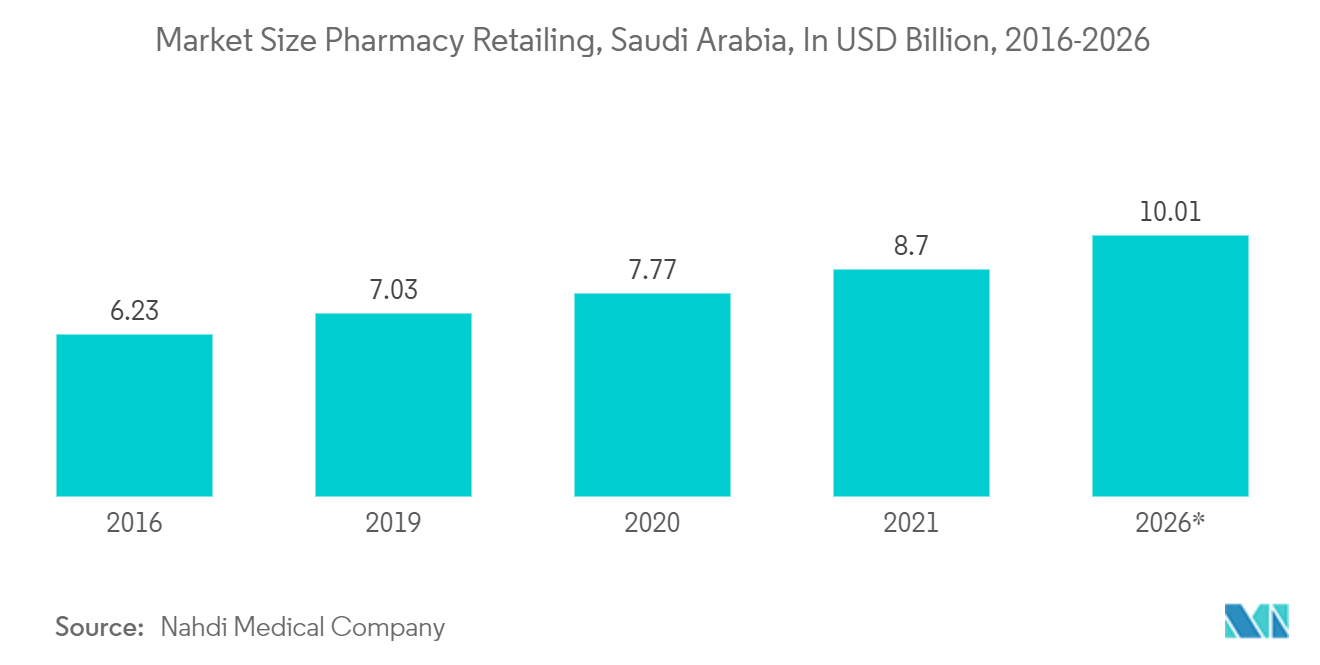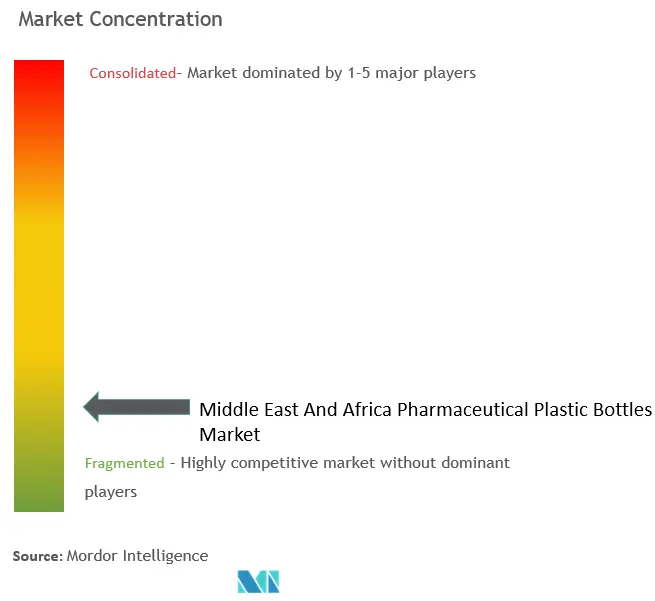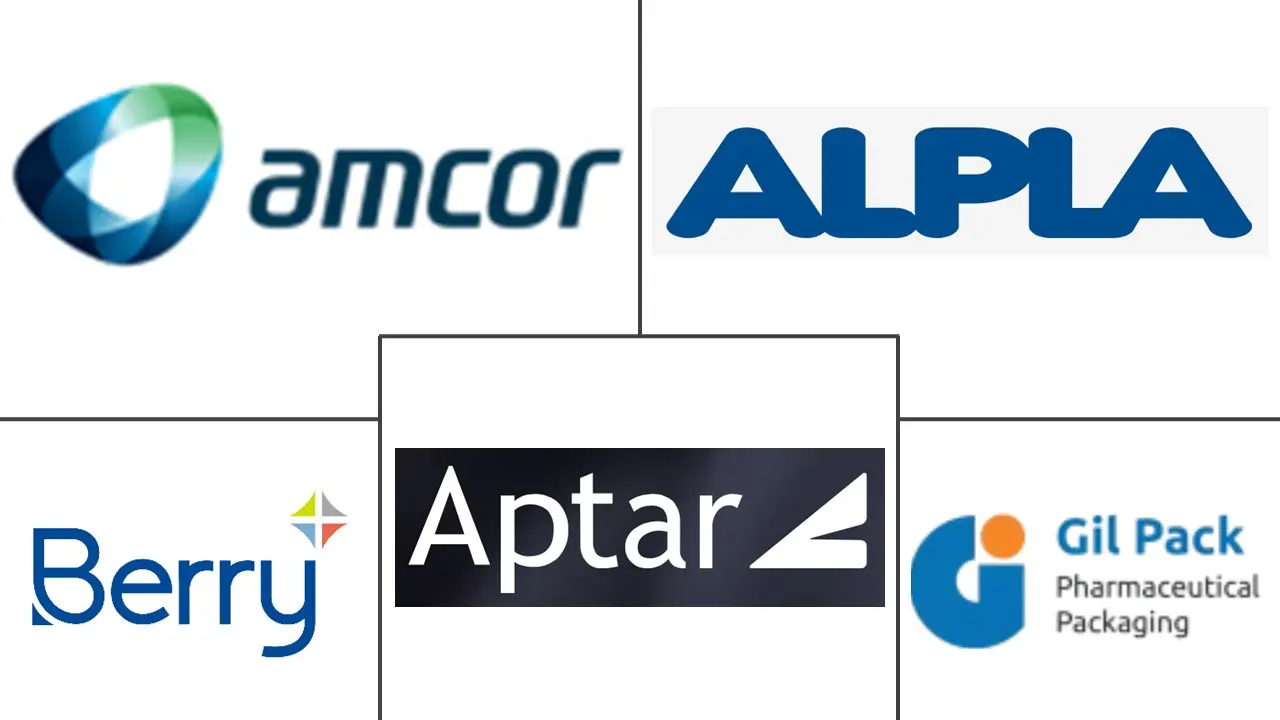MEA Pharmaceutical Plastic Bottles Market Size and Share

MEA Pharmaceutical Plastic Bottles Market Analysis by Mordor Intelligence
The MEA Pharmaceutical Plastic Bottles Market size is worth USD 0.77 Billion in 2025, growing at an 3.76% CAGR and is forecast to hit USD 0.92 Billion by 2030.
- Consumers are increasingly choosing plastic packaging solutions over other products due to their light weight and ease of handling. Major manufacturers are increasingly opting for plastic packaging solutions due to their lower production costs. The emergence of PET and HDPE polymers is expanding the scope of plastic bottle applications.
- As mentioned, plastic packaging solutions are typically more cost-efficient to manufacture than other materials, such as glass. This is especially beneficial for pharmaceutical companies, particularly in the Middle East and African countries, where cost sensitivity is a priority. Lower manufacturing costs can result in more competitive pricing of pharmaceutical products, thus attracting more customers and stimulating market growth.
- In addition, the National Committee of Pharmaceutical Industries (NCPI) stated that Saudi Arabia encourages the local production of pharmaceutical products by Vision 2030, thus increasing the demand for plastic bottles. The Vision 2030 initiative seeks to reform the healthcare sector. It is expected to revive market growth, likely stimulating the healthcare packaging market in Saudi Arabia. Several regional companies have concluded agreements to improve the recycling of their plastic bottles.
- Plastic bottles represent a severe environmental risk if they are not managed appropriately at the start of the value chain and throughout their prolonged existence, especially in the ocean. Due to increased plastic bottle production and use in the Arabian Gulf and shipping and waste disposal practices, the amount of plastic waste on the ocean’s surface and beaches has increased. Plastic bottle packaging companies must adhere to suitable recycling regulations to introduce their products in the region, restricting the market growth.
MEA Pharmaceutical Plastic Bottles Market Trends and Insights
Polyethylene Terephthalate (PET) is Expected to Witness Significant Growth
- PET bottles are crucial in the healthcare and pharmaceutical industry for storing, transporting, and dispensing medicines, syrups, ointments, and other liquid pharmaceutical products. These bottles are designed to meet stringent quality standards, ensuring the integrity and safety of the products. Many medications, particularly those for children, are formulated as syrups or suspensions.
- PET bottles with calibrated dosage measurements are used to dispense these liquid medications accurately. These bottles often feature child-resistant closures to ensure the safety of young patients.
- The UAE pharmaceutical plastic bottles market is anticipated to reach USD 4.7 billion by 2025, with 23 production facilities and 2,500 domestically made medications. Pharmax Pharmaceuticals monitors the development of the market and its prospects.
- Almost 2,500 items are made locally, and 23 pharmaceutical manufacturing facilities are located in the United Arab Emirates, according to Abu Dhabi holding firm ADQ. Such significant growth in the market would create significant opportunities for various PET bottle vendors to capture the demand.
- The rising expansion activities in the manufacturing facilities of pharmaceutical companies in the region would increase the demand for plastic bottles. In addition, the country’s strategic priority to local vendors for supplying secondary packaging in the region’s health department is creating an opportunity for the proliferation of the plastic bottles market in the pharma sector due to their application in storing, selling, and leveling the products.
- Higher healthcare expenditure generally means more funds allocated toward purchasing pharmaceutical products. This surge in demand will require a proportional increase in packaging solutions, including pharmaceutical plastic bottles. According to WHO, in 2020, the expenditure on healthcare for the United Arab Emirates (UAE) totaled USD 19.7 billion, and it is forecasted to reach USD 30.7 billion by 2027.

Saudi Arabia is Expected to Witness Significant Growth
- Saudi Arabia is widely known as a pharma manufacturing hub in the Middle East. With many domestic and international vendors setting up businesses with local generic manufacturers, there is a scope for robust, secure, organic growth, which is expected to drive the demand for packaging.
- Rising healthcare spending is poised to drive the adoption of packaging technologies. Notably, advancements in plastic bottle manufacturing enhance safety, prolong shelf life, and boost patient adherence. As per the International Trade Administration's data from January 2024, Saudi Arabia commanded a significant 60% share of the GCC's healthcare expenditures.
- Saudi Arabia heavily relied on imported pharmaceuticals to meet its healthcare demands. However, the nation is now actively pursuing self-sufficiency, aiming to reduce imports by incentivizing local research and development investments for pharmaceutical and therapeutic products. Concurrently, several GCC nations, including Qatar, Saudi Arabia, and the United Arab Emirates, are forging strategic partnerships with leading pharmaceutical manufacturers globally, further fueling the growth of their medicine and drug production capabilities.
- Projections from Nahdi Medical Company indicate that by 2026, the pharmacy retailing market in Saudi Arabia will reach SAR 37.6 billion (USD 10.01 billion), up from SAR 32.7 billion (USD 8.70 billion) in 2021. With the expanding pharmacy retailing landscape, the demand for pharmaceuticals, including medications, is set to surge. Consequently, there will be a heightened need for pharmaceutical plastic bottles to package these products while meeting regulatory standards securely.

Competitive Landscape
The Middle East and African pharmaceutical plastic bottles market is fragmented. Major market players include Amcor Group GmbH, Berry Global Inc., Gil Plastic Products Ltd, and ALPLA Werke Alwin Lehner GmbH & Co KG. To dominate the market, the players have adopted various organic and inorganic strategies, such as mergers and acquisitions, partnerships, new product launches, and collaborations.
- May 2024: Amcor Rigid Packaging launched the 'Bottles of the Year' initiative. Amcor's initiative highlighted packaging designs that were tailored to consumer trends. Emphasizing a commitment to responsible packaging, Amcor's designs are manufactured to align with evolving consumer preferences, especially in the healthcare sector.
- February 2023: Berry Global Healthcare introduced a comprehensive bundle solution to help customers capitalize on the increasing demand for child-resistant (CRC) and tamper-evident (TE) packaging for the pharmaceutical and herbal market for syrup and liquid medicines. The new Berry Healthcare bundle has seven ranges of 28 mm neck PET bottles in sizes from 20 ml to 1,000 ml and various designs, with eight accompanying closures incorporating tamper-evident and child-resistant features.
MEA Pharmaceutical Plastic Bottles Industry Leaders
Amcor Group GmbH
Berry Global Inc.
Gil Plastic Products Ltd
Silgan Holdings Inc.
AL AMANA PLASTICS
- *Disclaimer: Major Players sorted in no particular order

Recent Industry Developments
- May 2024: Berry Global Group Inc., a prominent player in designing, developing, and manufacturing patient-centric healthcare solutions, bolstered its healthcare production capacity by investing in new assets and manufacturing capabilities, aiming for a significant 30% increase.
- June 2023: Lifera, a Saudi Arabian biopharmaceutical company, and Sanofi, a global player in vaccine development, partnered with Arabio and signed a Memorandum of Understanding (MOU). The primary goal of this agreement is to enhance the domestic production of vaccines in Saudi Arabia. The partnership with global player Sanofi ensures that the vaccines produced adhere to high-quality standards. This will likely extend to the packaging materials, including plastic bottles, driving demand for high-quality, compliant pharmaceutical packaging solutions in the region.
- January 2023: Niner Pharmaceuticals LLC, a pharmaceutical firm established in the UAE, announced plans to create a complete supply chain between the Indian and Middle Eastern markets. The business is building advanced manufacturing facilities in India to achieve this goal. International agencies for pharmaceutical products, such as the USFDA, EU, and UK MHRA, will certify these production facilities. The company is expected to increase its operations this way and satisfy the rising demand in the Middle Eastern markets.
MEA Pharmaceutical Plastic Bottles Market Report Scope
Pharmaceutical plastic bottles are containers specifically designed and manufactured for the storage and distribution of pharmaceutical products. These bottles are an essential component of the pharmaceutical packaging industry and play a crucial role in maintaining the safety, efficacy, and integrity of medications and other healthcare products.
The pharmaceutical plastic bottles market in the Middle East and Africa is segmented by raw material (polyethylene terephthalate (PET), polypropylene (PP), low-density polyethylene (LDPE), and high-density polyethylene (HDPE)), type (solid containers, dropper bottles, nasal spray bottles, liquid bottles, oral care, and other types), and country (Saudi Arabia, United Arab Emirates, South Africa, Egypt, and the Rest of Middle East and Africa). The report offers market forecasts and sizes in value (USD) for all the above segments.
| Polyethylene Terephthalate (PET) |
| Polypropylene (PP) |
| Low-density Polyethylene (LDPE) |
| High-density Polyethylene (HDPE) |
| Solid Containers |
| Dropper Bottles |
| Nasal Spray Bottles |
| Liquid Bottles |
| Oral Care |
| Other Types |
| Saudi Arabia |
| United Arab Emirates |
| South Africa |
| Egypt |
| By Raw Material | Polyethylene Terephthalate (PET) |
| Polypropylene (PP) | |
| Low-density Polyethylene (LDPE) | |
| High-density Polyethylene (HDPE) | |
| By Type | Solid Containers |
| Dropper Bottles | |
| Nasal Spray Bottles | |
| Liquid Bottles | |
| Oral Care | |
| Other Types | |
| By Country* | Saudi Arabia |
| United Arab Emirates | |
| South Africa | |
| Egypt |
Key Questions Answered in the Report
How big is the MEA Pharmaceutical Plastic Bottles Market?
The MEA Pharmaceutical Plastic Bottles Market size is worth USD 0.77 billion in 2025, growing at an 3.76% CAGR and is forecast to hit USD 0.92 billion by 2030.
What is the current MEA Pharmaceutical Plastic Bottles Market size?
In 2025, the MEA Pharmaceutical Plastic Bottles Market size is expected to reach USD 0.77 billion.
Who are the key players in MEA Pharmaceutical Plastic Bottles Market?
Amcor Group GmbH, Berry Global Inc., Gil Plastic Products Ltd, Silgan Holdings Inc. and AL AMANA PLASTICS are the major companies operating in the MEA Pharmaceutical Plastic Bottles Market.
What years does this MEA Pharmaceutical Plastic Bottles Market cover, and what was the market size in 2024?
In 2024, the MEA Pharmaceutical Plastic Bottles Market size was estimated at USD 0.74 billion. The report covers the MEA Pharmaceutical Plastic Bottles Market historical market size for years: 2019, 2020, 2021, 2022, 2023 and 2024. The report also forecasts the MEA Pharmaceutical Plastic Bottles Market size for years: 2025, 2026, 2027, 2028, 2029 and 2030.
Page last updated on:
MEA Pharmaceutical Plastic Bottles Market Report
Statistics for the 2025 MEA Pharmaceutical Plastic Bottles market share, size and revenue growth rate, created by Mordor Intelligence™ Industry Reports. MEA Pharmaceutical Plastic Bottles analysis includes a market forecast outlook for 2025 to 2030 and historical overview. Get a sample of this industry analysis as a free report PDF download.



